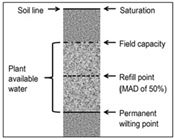Too Much Too Soon
DR. AVAT SHEKOOFA
JACKSON, TENN.
Soybeans lose gallons of water daily during hot, dry conditions through transpiration. Plants transpire, or lose more than 98 percent of water taken up by the roots, through leaf tissue. Evapotranspiration (ET) describes the movement of water through evaporation from the soil and transpiration through plant surfaces, which is the movement of water from the soil into plant roots, through plant stems and leaves, and back out into the atmosphere. The rate of ET depends upon the soybean growth stage and the time of the year (Fig 1.) Both transpiration and evaporation need to be considered when it comes to irrigation scheduling.
Soybeans generally require from 15 to 25 inches of water per acre per year for maximum yield potential. In general, (Fig 1.), the most important time to irrigate soybeans is from R3 (beginning pod, one pod 3/16 inch long on one of the upper four nodes on the main stem having unrolled leaves) through R6 (full seed, one pod containing green seed that fills the pod cavity on one of the upper four nodes on the main stem having unrolled leaves). Water applied at R1 to R3 encourages flower and pod retention. Delaying irrigation until R1 (first bloom) or R3 (beginning pod), often provides equal or better yields than when irrigation treatments were begun during the vegetative stages. Please find Dr. McClure recommendation here:
http://news.utcrops.com/2018/06/corn-and-soybean-irrigation-reminders/#more-16633
For the best irrigation scheduling:
• check the soil type
• be aware of the soil water holding capacity
• document location, planting date, variety type and maturity group
• have accurate rainfall or weather data
To effectively use weather-based crop water use estimates, producers need to estimate how much soil moisture is available for plants uptake (Table 1) and how much is being used by the crop in a given day. See the soil profile figure (Fig 2).
If soil moisture sensors are used, keep in mind approximately 70 percent of plant roots are within the top half of plant root depth. This results in about 70 percent of soil water use also occurring in the top half of plant root depth. Calibrating and placing sensors within the root zone will provide precise measurements of soil moisture for irrigation scheduling. Please see table 1. It may come in handy. ∆
DR. AVAT SHEKOOFA: Crop Physiologist, University of Tennessee

Figure 1: Soybean water use with select growth stages.

Figure 2: Showing the soil water content. Not in plant favor if the soil moisture drops to the permanent wilting point level. The Maximum Allowable Depletion (MAD) indicates when irrigation should be applied. Potential yield loss occurs at MAD level.